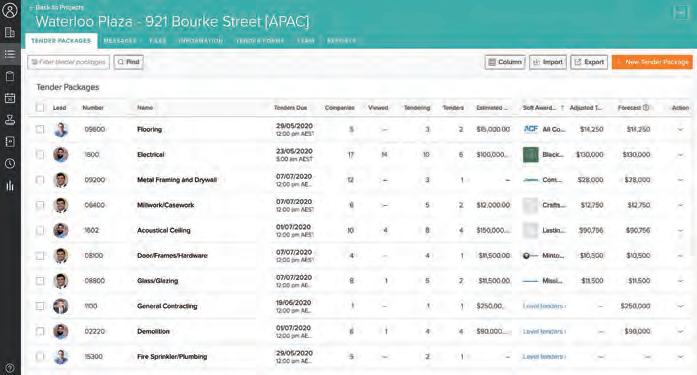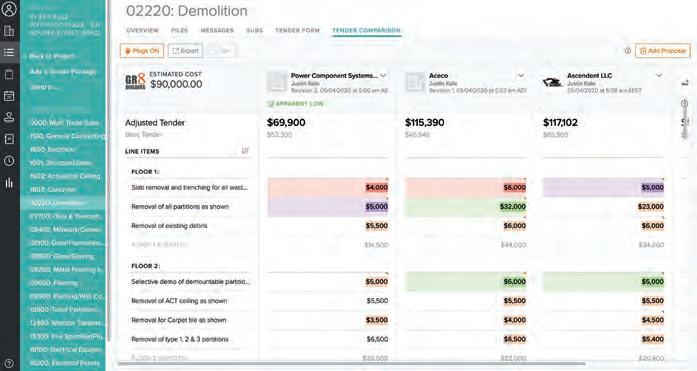
4 minute read
Connecting construction
BUILDING A
NETWORK
IN OCTOBER, AUTODESK RELEASED ITS BUILDINGCONNECTED PLATFORM IN AUSTRALIA. ALREADY USED BY MORE THAN ONE MILLION CONSTRUCTION PROFESSIONALS IN NORTH AMERICA, THE PLATFORM IS EXPECTING TO BRING A NEW LEVEL OF CONNECTIVITY TO AUSTRALIAN CONSTRUCTION.
BuildingConnected is a tender management solution, acquired by Autodesk in 2019, for preconstruction teams to manage the tender process.
Created like a social networking platform for contractors, BuildingConnected features a crowd-sourced directory of builders, with up-to-date contact information that includes work history and qualifications.
Asset owners and contractors alike can access the network to discover trade partners, identify the right subcontractor for the job and solicit and compare tenders, within one centralised solution.
BuildingConnected’s popularity in North America, with over 2,000 general contractors and owners actively bidding out projects – totalling $56 billion USD ($79 billion AUD) in project values each month, is a sign of what can be enabled in the Australian construction network.
Roads & Infrastructure sits down with Zac Hays, director of product, preconstruction at Autodesk Construction Solutions to find out what BuildingConnected’s capabilities will mean for Australian contractors. CONNECTING CONSTRUCTION “The mission for BuildingConnected was to build the best network for businesses and professionals in the construction market,” Hays explains.
As construction jobs increase in size and continue to develop, project teams grow and major projects can require hundreds of specialised subcontractors and suppliers.
“Construction companies are constantly forming cross-company teams. For example, one of the projects in America that used BuildingConnected was for the construction of a new NBA basketball stadium and there were more than 1,000 companies involved with building that infrastructure,” Hays says.
“One of the core things with this network approach is that it saves time in finding contractors and sending tenders out, but the head contractor will also get more bids back because the network has accurate contact information,” Hays explains.
“It can be really difficult to coordinate and collaborate or even to connect with this many companies to source all of the qualified tenders for some projects.”
When getting started with BuildingConnected, Autodesk will load all of a company’s existing list of tender invitations onto the network. During this process the software-as-a-service will detect duplications or contact information that needs to be updated.
“As you invite more people to tender, the system will update and if one of the contacts has a profile on the platform, it will update their contact details when they change roles or occupations,” Hays explains.
From there, the platform allows users to track and follow-up with subcontractors while storing all of the project information.
“We really pride ourselves on the accuracy of the network, which eliminates the process of finding the right contractors to ensure you have invited as many options as possible to tender. If your contact at your favourite sub-contractor isn’t there, the platform will make suggestions for who to
contact instead.”

In addition to BuildingConnected’s networking features, the platform also includes artificial intelligence tools to help manage the tender process.

USING DATA AS A TOOL In addition to BuildingConnected’s networking features, Autodesk has built a number of artificial intelligence tools into the platform to help manage the tender process and to bring structure to the evaluation of tender submissions.
Research recently released by Autodesk has shown specialty contractors in Australian and New Zealand identify centralised communication as a top quality in determining repeat business with a subcontractor.
“You can structure a tender form so that the tenders that come in can be lined up side-by-side to easily compare the best bid, identifying the benefits that can be achieved with each company,” Hays says.
“Once a tender has been solicited, documents and plans can be exchanged through the platform, creating an automated communication tool between head contractors and subcontractors.”
A head contractor would be able to manage not just their contacts, but also which subcontractor has viewed, bid and won the project.
All historical data is stored in BuildingConnected’s platform, so when

working on the next project, contractors can review previous tendering performance to improve future project outcomes.
“Every time a tender comes back, it is logged in a history report. You can start using historical information to inform your estimates for new jobs and compare it to previous tenders. BuildingConnected helps personalise the tender management process by learning a company’s preferred contractors for certain types of jobs or predicting which companies you may be likely to use in the future,” Hays explains.
“During the pandemic, Autodesk has seen how important it is for companies to choose the right partner to reduce project risks.”
BuildingConnected was released in Australia in October and is already growing its network of contractors as we speak. The release came shortly after the Australian Government’s Budget announcement promising $7.5 billion dollars for transport infrastructure projects across the country.
“Also, we make it as easy as possible for sub-contractors to join the platform. It’s free for them to use and get invited to tender on projects, which in turn they see displayed on their own dashboard,” Hays says.
“We are really excited about the release of BuildingConnected, we are starting with a solid network and we expect it to quickly grow and gain popularity throughout the industry.”










